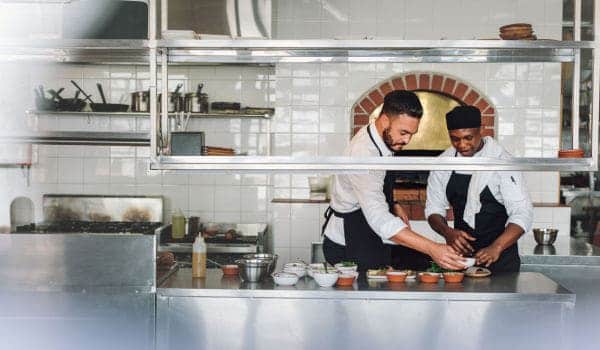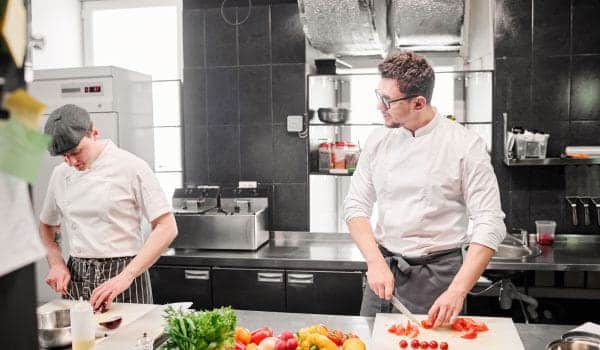The modern kitchen brigade system is a structured approach to culinary organization that originated in the 19th century under the guidance of renowned Auguste Escoffier. It serves as a hierarchical framework, dividing kitchen staff into specialized roles to enhance efficiency and coordination. In this system, each member plays a crucial part in ensuring the smooth operation of the kitchen, from the head to various sous and line cooks.
The importance of roles within this system lies in the delegation of responsibilities, allowing for a well-organized and synchronized workflow that is essential for meeting the demands of a high-paced culinary environment. As kitchens have evolved, the roles have adapted to contemporary needs, emphasizing collaboration, creativity, and effective communication among team members. This overview highlights the significance of the kitchen brigade system in fostering a structured and productive culinary environment.
The Modern Kitchen Brigade System

The modern kitchen brigade system, rooted in the culinary legacy of Auguste Escoffier, has undergone a fascinating evolution since its inception in the 19th century.
Origin and evolution of the kitchen brigade system:
The concept was first formalized by Escoffier to bring order and efficiency to the chaotic kitchen environments of the time. Over the years, it has evolved to accommodate changes in culinary practices, technology, and the demands of contemporary dining experiences. The foundational principles established by Escoffier continue to influence kitchen organization and teamwork.
Key roles and responsibilities in the modern kitchen brigade:
Within the modern kitchen brigade, distinct roles contribute to the seamless functioning of a culinary establishment. From the visionary leadership of the head chef to the meticulous execution by line cooks, each role is designed to optimize efficiency, maintain quality, and ensure a harmonious culinary workflow. The division of labor and specialization allows for a more focused and productive kitchen environment.
The Second Chef Role:

Definition and significance:
The second chef, often referred to as the sous, holds a pivotal position within the kitchen hierarchy. This role is characterized by its significance in supporting the head and maintaining kitchen operations. The sous is instrumental in executing the head vision while overseeing various aspects of food preparation, quality control, and staff management.
Evolution of the second chef role in the kitchen brigade system:
The role of the second has evolved from being primarily an assistant to the head to a more collaborative and leadership-oriented position. In modern kitchens, sous are valued not only for their culinary expertise but also for their ability to manage teams, coordinate kitchen activities, and contribute to menu development.
Responsibilities and duties of the second chef:
The second is tasked with a diverse set of responsibilities, including supervising kitchen staff, ensuring adherence to recipes and standards, and managing inventory. Additionally, they play a crucial role in fostering a positive and efficient work environment, facilitating effective communication, and stepping in to lead the kitchen in the absence of the head. The evolution of this role reflects the dynamic nature of culinary arts and the ever-changing demands of the hospitality industry.
Qualities and Skills of the Second Chef:

Culinary expertise:
The second chef, or sous, must possess a high level of culinary proficiency. This includes a deep understanding of various cooking techniques, a broad knowledge of ingredients, and the ability to create and execute complex recipes. Culinary creativity and a passion for gastronomy are essential components of their skill set.
Leadership and communication skills:
Effective leadership is a hallmark of a successful second chef. This role involves not only overseeing kitchen operations but also inspiring and guiding the kitchen team. Strong communication skills are crucial for conveying the head vision, providing clear instructions, and maintaining a positive and collaborative atmosphere in the kitchen.
Ability to coordinate and manage the kitchen team:
The second plays a pivotal role in orchestrating the activities of the kitchen brigade. This requires exceptional organizational skills to ensure a smooth workflow, timely preparation, and efficient service. The ability to delegate tasks, motivate team members, and address challenges in real time contributes to the overall effectiveness of the kitchen.
Distinction Between Head Chef and Second Chef

Contrasting roles and responsibilities
While both the head and the second share the goal of maintaining culinary excellence, their roles differ significantly. The head is typically responsible for overall kitchen management, menu creation, and strategic decision-making. On the other hand, the second focuses on day-to-day operations, staff supervision, and ensuring the execution of the head chef’s vision.
The collaborative nature of the relationship between the head chef and second chef
The relationship between the head and the second is inherently collaborative. It relies on open communication, trust, and a shared commitment to culinary excellence. The second acts as a crucial support system for the head chef, implementing their directives while contributing valuable insights and feedback. This collaborative dynamic enhances the overall efficiency and creativity of the kitchen brigade system, fostering a unified approach to culinary innovation.
Training and Career Path for Second Chefs

Educational background and culinary training
Aspiring second typically embark on their culinary journey through formal education, often obtaining degrees or diplomas from reputable culinary schools. These programs provide a foundation in culinary arts, introducing students to various cooking techniques, kitchen management, and menu planning. Additionally, specialized courses in leadership and communication may further enhance their skill set.
Practical experience and on-the-job learning:
Practical experience is invaluable in the development of a second expertise. Many start in entry-level positions, working their way up through the ranks. Apprenticeships and internships provide hands-on experience in a professional kitchen, exposing individuals to the fast-paced and demanding nature of the culinary industry. On-the-job learning allows aspiring second to refine their skills, adapt to real-world challenges, and gain a comprehensive understanding of kitchen operations.
Advancement opportunities within the kitchen brigade system
The path to becoming a second involves progressive advancement within the kitchen brigade. After gaining experience as a line cook or junior, individuals may be promoted to the position of sous chef. Continuous learning, commitment, and a proven track record of effective leadership contribute to further career progression. Some second may eventually aspire to become head chefs, overseeing entire kitchen operations and shaping culinary direction.
Challenges and Innovations in the Second Chef Role

Addressing common challenges faced by second chefs
Second encounter various challenges, including managing a diverse team, ensuring consistency in food quality, and handling high-pressure situations. Effective communication and leadership skills are essential in overcoming these challenges. Additionally, adapting to changing dietary trends, maintaining cost efficiency, and balancing creativity with operational constraints are ongoing considerations for second in the modern culinary landscape.
Embracing technological advancements in the culinary industry
Technological innovations have significantly impacted the culinary industry. Second must adapt to the integration of digital tools for inventory management, recipe development, and kitchen organization. Embracing these advancements not only streamlines operations but also allows for greater precision and efficiency in the kitchen.
Case Studies
Examples of renowned second chefs in the culinary world
Thomas Keller’s Sous Chefs at The French Laundry
Explore the contributions of sous in Thomas Keller’s renowned restaurants, highlighting their role in maintaining the high standards for which Keller is known.
Success stories and contributions to the Kitchen Brigade system
Gordon Ramsay’s Protégés
Examine the career paths of those who trained under Gordon Ramsay, showcasing how successful second has made significant contributions to the culinary world.
Conclusion
The role of the second within the modern kitchen brigade system is dynamic and multifaceted, requiring a combination of education, practical experience, and leadership skills. The educational background and culinary training provide a solid foundation, but it is the on-the-job learning and practical experience that shape expertise.
Advancement opportunities within the kitchen brigade system underscore the importance of continuous learning and career progression. The challenges faced by second, from team management to adapting to technological advancements, highlight the resilience and adaptability required in this profession. Case studies of renowned second offer insights into their contributions, emphasizing the collaborative nature of the kitchen brigade system. Success stories, such as those emerging from Gordon Ramsay’s kitchens, illustrate how second plays a pivotal role in shaping the culinary landscape.




